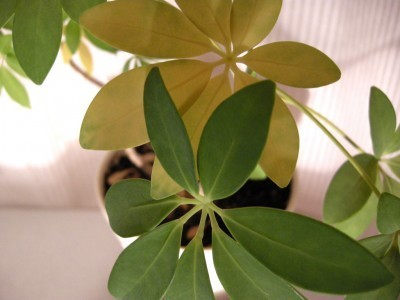






The leaves are brown and crisp, the foliage is lifeless, the plant won’t bloom, or perhaps there are holes in the leaves. What causes these ailments and how can they be treated? Most cases of ailing houseplants involve some type of environmental deficiency, such as excessive or insufficient light and water. Keep reading to learn more.
To keep your houseplants as healthy as possible, it helps to become familiar with some of the most common houseplant afflictions and their remedies.
Browning leaf edges/tips – When the leaf edges are brown and crisp or new growth withers, your houseplant may be suffering from a variety of things such as low humidity or high temperatures. Likewise, the plant may have been allowed to dry out completely between watering intervals. Try using a lower temperature and increase both the watering and humidity levels.
Another possibility is the buildup of salt, which can be leached from the soil by running water through it. Leaf margin and tip burn can often be attributed to too much fertilizer, with excess salt accumulating on the leaves. Cut back on fertilizing and give leaves a thorough cleaning with water.
Holes in leaves – Holes in the leaves are usually associated with poor nutrition or hot, dry air. Many people believe insects cause this; however, unless you keep the plant outdoors, this is rarely the case.
Wilting foliage – Lifeless foliage and continual wilting can mean that your pot may be too small and the plant too dry. Repotting your houseplant may be necessary. Transplant into a larger container and add plenty of moisture.
Lack of blooms – If you’re having problems getting your houseplant to flower, then you may need to give it more light as well as increase phosphorus fertilizer. If the problem is due to bud drop, you may need to check for drafts. The plant could be too dry from lack of adequate humidity as well. Try misting the plant with water and increase humidity levels.
Moss or mushroom growth – If you happen to notice moss or mushroom growth on the soil surface of your houseplant, don’t go crazy. In most instances, this will not harm the plant; however, it may signal poor drainage. You can try aerating the soil or adding more perlite or sand.
Fuzzy mold on plants – When you spot fuzzy, grey mold on your flowers, leaves or stems, your houseplant may be suffering from what is referred to as Botrytis blight, a fungal disease. This is normally caused by too much humidity, poor ventilation, or spent flowers and leaves left on the plant. Clean the plant, picking off all dead growth and wiping away the mold. You may want to remove the plant and repot. Decrease the amount of humidity and provide adequate ventilation.
Yellowing leaves – Yellow foliage can signal distress from excessive light, poor drainage, overwatering, or too much lime in the water. Try to limit light, aerate the soil (poking holes in it), water less often and filter the water before applying to the plant. Also, gently remove the yellowed leaves. If the lower leaves turn yellow and begin dropping off, your houseplant may need more humidity, fertilizer or a new location. Pests could be another possibility. Check for pests and treat with neem oil.
Leaves dropping off – If the plant is suffering from gradual defoliation, it could also have root damage caused from overwatering. On the other hand, if the defoliation is rapid, the plant may be experiencing shock attributed to drastic temperature changes. Continual leaf dropping may be an indication that your houseplant is being exposed to gases or other pollutants in the air. Try moving the plant to another location and provide adequate ventilation.
Spots on leaves – There are numerous reasons why a houseplant might suffer from spots on its foliage. Yellowish looking spots may be an indication that your water is too cold for the plant during watering. Use tepid water or allow it to reach room temperature before applying to plants. This could also be associated with bacteria leaf spot. Try improving the light conditions and reduce the amount of humidity. Pick off affected leaves as well.
Yellowish mottling of leaves could be attributed to spider mites. Check for this by tapping lightly on the leaves while holding a sheet of white paper beneath. Silvery or red blotches on the foliage typically indicate too much exposure to direct sunlight. Move the plant to another location with less direct light.
Droopy plants – Are you having problems associated with mushy stems or drooping of the entire plant? The most likely cause for this is overwatering or poor drainage. This results in crown or root rot. You could try improving drainage and allow the plant to dry out; however, depending on how sick the houseplant is, it may be too late. In some cases, this affliction can be attributed to soil-borne bacteria. Try repotting in another container with fresh, clean soil.
Leggy growth – If your plant problem is limited to only leggy or lopsided growth, then your houseplant most likely is suffering from low light or humidity. Simply improve the plant’s light conditions and increase humidity levels. Also, try to turn the plant on a regular basis to keep its growth even.
Stunted/weak growth – Stunted or weak plant growth can be caused by a myriad of things such as poor drainage and light conditions, low humidity and lack of suitable fertilizer. Try aerating the soil or repot, if necessary. Move the plant to an area with more suitable light and increase humidity levels. You should also give it an extra boost of fertilizer.
Copyright © www.100flowers.win Botanic Garden All Rights Reserved